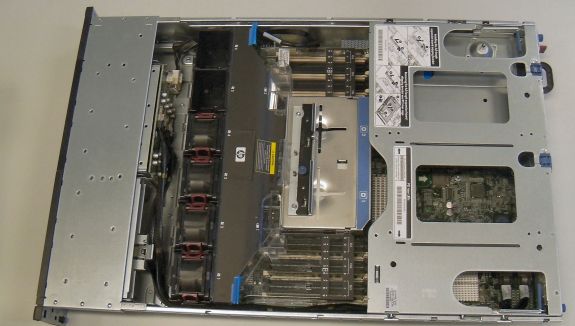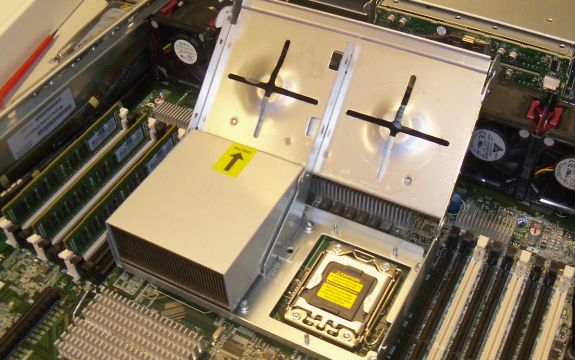Server Clash: DELL's Quad Opteron DELL R815 vs HP's DL380 G7 and SGI's Altix UV10
by Johan De Gelas on September 9, 2010 7:30 AM EST- Posted in
- IT Computing
- AMD
- Intel
- Xeon
- Opteron
HP Proliant DL380 G7
| CPU | Two Xeon X5670 at 2.93GHz |
| RAM | 15 x 4GB Samsung 1333MHz CH9 |
| Motherboard | HP proprietary? |
| Chipset | Intel 5520 |
| BIOS version | P67 |
| PSU | 2 x HP PS-2461-1C-LF 460W HE |
The 15x 4GB is not a typo. We wanted to give each server the same amount of memory while making sure that each system was working at the highest performance. In other words, each memory channel had be populated. In case of the HP DL380 G7 we populated the nine DIMMs of the first CPU, and the second CPU only got six DIMMs. This way each channel was populated, and the amount of memory (60GB) was close enough to the other systems (64GB). The extra power that one DIMM would add to the power consumption is taken in to account in the energy measurements. A DDR3 DIMM adds about 4W on average while being active.
The HP DL380 line is probably the most popular server in the world. It comes standard with four fans and one CPU. If you buy a second CPU, two fans are added to the design. The DL380 has eight 2.5 inch drive bays.

HP’s engineers have implemented quite a few great ideas: the number of sensors and the integration with the management software (ILO) is great. Lots of LEDs at the front panel give feedback to the administrator. The HP server ships with a PSU that is 92% or 94% efficient, and thus qualifies as an “80PLUS Gold” PSU. The second redundant PSU can be configured as being "cold redudant", not consuming a single watt when it is not necessary.
The CPU heatsinks can be placed on the CPU, and you simply have to close a metal “heatsink cage” to make sure that the heatsinks are applying the proper pressure on the CPUs. That makes replacing CPUs effortless and very safe.
But we are less enthusiastic about some of the “product differentiation choices”. For some weird reason, HP’s servers always ship with a few 1GB DIMMS even if you have customized the server with several tens of gigabytes. The servers is delivered with eight dummy drive bays, and you only get the functional drive bays for each disk that you order. The I/O cage is only fitted with one riser card: another optional riser card must be ordered separately. While this makes sense for HP as a vendor, in our opinion it is not customer friendly. This leads in many cases to extra deployment delays as buyers have to order something extra after the server has arrived.












51 Comments
View All Comments
JohanAnandtech - Friday, September 10, 2010 - link
Thanks, appreciate you took the time to let us know. We went through 5 weeks of intensive testing and my eyes still hurt from looking at the countless excel sheets, with endless power and response time readings. ;-)FourthLiver - Thursday, September 9, 2010 - link
at the end of page 12, you allude to a performance per watt analysis. looks like you forgot to put it up. i'm chomping at the bit to see those numbers!please disregard me if i failed to rtfa correctly. Anandtech is the best; your (all of you collectively) articles are brilliant and correct down to the smallest details. This is another article that was an absolute joy to read. :]
JohanAnandtech - Thursday, September 9, 2010 - link
Well you can't really calculate it, as it depends on the situation. On low load loads, the system that consumes the less, is the winner, on the condition that the response times stay low. But of course, if your systems are running at low load all time, there might be something wrong: you should have bought more RAM and consolidated more VMs per system.At higher loads, the power consumption at high load divided by the throughput (vApusmark) is close to the truth. But it is definitely not the performance/watt number for everyone
It depends on your workloads. The more critical processing power (think response time SLA) is, the more the last mentioned calculation makes sense. The more we are talking about lots of lightly loaded VMs (like authentification servers, fileservers etc.), the more simply looking at the energy consumed at page 12 make sense.
mino - Thursday, September 9, 2010 - link
First, congratulations to a great article !Now to the small ammount of mess in there:
"the CPUs consume more than the ACP ratings that AMD mentions everywhere"
1) Avegare CPU Power (ACP) is NOT supposed/marketed to represent 100% load power use
Wikipedia: "The average CPU power (ACP), is a scheme to characterize power consumption of new central processing units under "average" daily usage..."
2) 122W at the wall and 110W at the CPU ??? Are you telling us the PSU's are 95% along with VRM/power/fans at 95% efficiency ? (0.95*0.95*1.22=1.10)
. Sorry to spoil the party but that is NOT the case. 122W at wall means 100W at CPU at the most realistically 95W.
Otherwise a great work. Keep is up!
JohanAnandtech - Friday, September 10, 2010 - link
"1) Avegare CPU Power (ACP) is NOT supposed/marketed to represent 100% load power useWikipedia: "The average CPU power (ACP), is a scheme to characterize power consumption of new central processing units under "average" daily usage...""
You are right. But what value does it have? As an admin I want to know what the maximum could be realistically (TDP is the absolute maximum for non-micro periods) and if you read between the lines that is more or less what AMD communicated (see their white paper). if it is purely "average", it has no meaning, because average power can be a quite a bit lower as some servers will run at 30% on average, others at 60%.
These PSU are supposed to be 92-94% efficient and AFAIK the VRMs are at least 90% efficient. So 122 x 0.92 x 0.90 = 101 W.
mino - Saturday, September 11, 2010 - link
Well, I was bit unslept when writing it but anyway. So got a bit harser than should have.In my experience the ACP values pretty well represent your average loaded server (<= 80% load). But that is not the point.
AMD created ACP in a response to the fact that their TDP numbers are conservative while Intel's are optimistic. That was the main cause wery well known to you as well.
Call me an ass but I certainly do not remember AT bitching about Intel TDPs no bein representative (during last 6 years at least).
And we all know too well that those NEVER represented the real power use of their boxen nor did they EVER represented what the "TDP" moniker stands for.
Currently the situation is as such that identical 2P AMD box with 80W ACP has ~ the same power requirements as 2P Intel box with 80W TDP. You have just proven that.
Therefore I believe it would be fair to stop bitching about AMD (or Intel) cheating in marketing (both do) and just say whether the numbers are comparable or not.
Arguing about spin wattage is not really needed.
JohanAnandtech - Monday, September 13, 2010 - link
"Arguing about spin wattage is not really needed. "I have to disagree. The usual slogan is "don't look at TDP, look at measurements". What measurments? The totally unrealistic SPECpower numbers?
It is impossible for review sites to test all CPUs. So it is up to vendors to gives us a number that does not have to be accurate on a few percent, but that let us select CPUs quickly.
Customers should have one number that allows them to calculate worst case numbers which are realistic (heavily load webserver for example, not a thermal virus). So all CPU vendors should agree on a standard. That is not bitching, but is a real need of the sysadmins out there.
mino - Thursday, September 9, 2010 - link
One thing I would love to see is having the lowest end HP server put to its paces.So far it seems to us a the best option for vCenter hosting in small environments (with FT Vm's hosting vCenter).
Maybe even run 1-tile vAPUS (v1? perhaps) on it ?
m3rdpwr - Thursday, September 9, 2010 - link
I would have prepared to have had the DL385 G7 compared.They can be had with 8 and 12 core CPU's.
We have close to 200 HP servers of all models, rack and blades.
Many running vm in our Data Center.
-Mario
duploxxx - Friday, September 10, 2010 - link
same here, we moved also to 385g7 with the new 8-12core cpu's, Nice servers with huge core count since we never run more vCPU then pCPU in a system. Dell 815 looks like a good solution also, it was mentioned in the review the BL685 and DL585 are way more expensive.